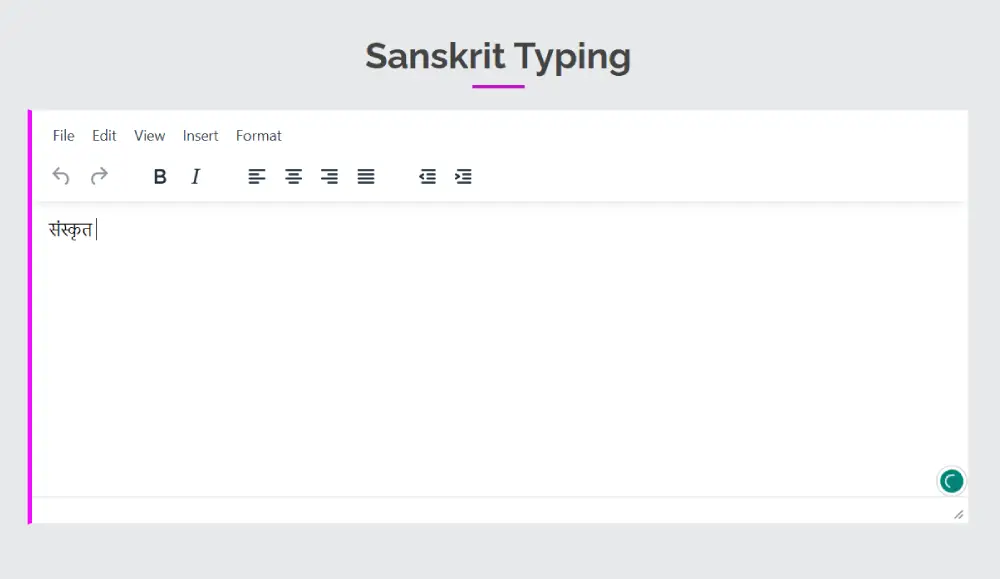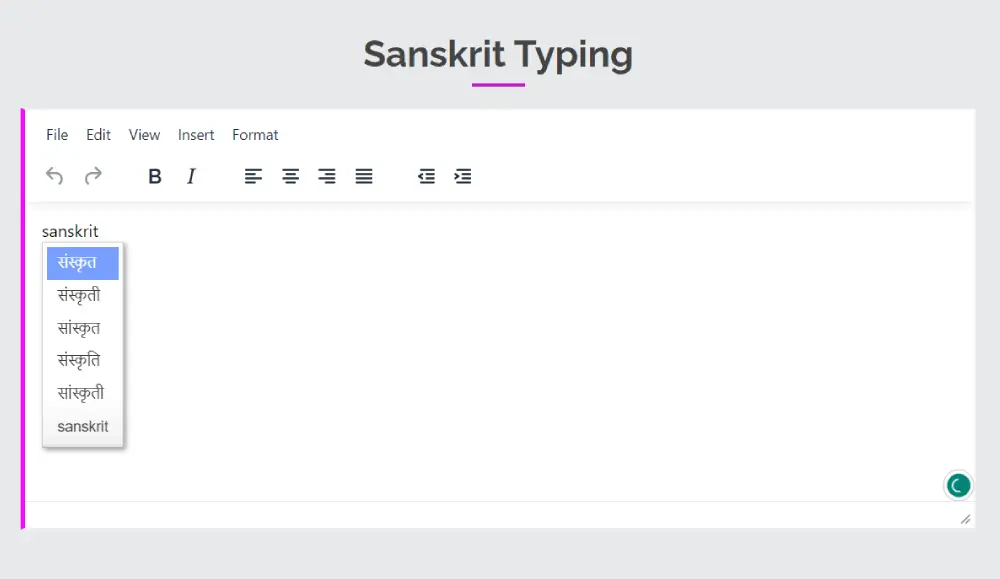Get Started with Our Sanskrit Typing Tool
Our Sanskrit typing tool makes it easy to type in Sanskrit without any technical knowledge or software downloads. All you need to do is visit our website and start typing! Our intuitive layout ensures that you`ll be able to quickly navigate the page and get started with your typing. Best of all, you don`t have to worry about accuracy - our tool will automatically detect and correct mistakes as you type! In mobile when you type in all the given text-area space, your content fills the text-area and if you want to increase the size of the text area, you can expand its size each time you press the button EXPAND and after completion and start a new content typing press the button SHRINK and the text area will be back to its original size. On the desktop, once the text has been typed into the desired language, all you need to do is select it all, press “ctrl-c,” copy it, and then press “ctrl-v” to paste it back into your document. When you are on mobile just simply click the COPY button and copy all your text and then paste it into your desired location. And also clear your text area after typing press the CLEAR button and you can type other contents as you like.
Unable to find the correct transliterate?


Sanskrit Language
Sanskrit is an ancient Indo-Aryan language that was used as a means of communication in ancient India. It is considered one of the oldest languages in the world, with a history dating back over 3,000 years. Sanskrit is known for its complex grammar and rich literary tradition, which includes religious texts such as the Vedas and the Upanishads, as well as poetry, drama, and scientific treatises. The language fell out of common use around the 11th century AD, but it continues to be studied and used in Hindu religious rituals and as a ceremonial language.
History of Sanskrit
It is believed to have originated in the second millennium BCE as a dialect of the Indo-Aryan branch of the Indo-European language family. The earliest known texts written in Sanskrit are the Vedas, a collection of religious hymns and rituals, which date back to around 1500 BCE.
In ancient India, Sanskrit was used as a language of religion, learning, and courtly life. It was the language of the elite, and it was used to write religious texts, poetry, plays, and scientific treatises. It was also used as the language of education and scholarship.
During the time of the Gupta Empire (4th century CE to 6th century CE), Sanskrit literature reached its peak and produced many great works, including plays, poetry, and treatises on grammar, philosophy, and science.
After the decline of the Gupta Empire, the use of Sanskrit gradually declined, and it was eventually replaced by other languages, such as Prakrit and Apabhramsa, which eventually evolved into the modern languages of India. However, it continued to be used in Hindu religious rituals and as a ceremonial language.
Today, Sanskrit is considered a classical language and is still studied and used in Hindu religious rituals, as well as by scholars and linguists interested in its history and structure. It is also being revitalized as a spoken language in some communities.
Sanskrit Scripts (संस्कृत लिपि)
Consonants (विसर्गाः)
क, ख, ग, घ, ङ, च, छ, ज, झ, ञ, ट, ठ, ड, ढ, ण, त, थ, द, ध, न, प, फ, ब, भ, म, य, र, ल, व, श, ष, स, ह, क्ष, त्र, ज्ञ, श्र
Vowels (स्वराः)
अ, आ, इ, ई, उ, ऊ, ऋ, ए, ऐ, ओ, औ, अं, अः, ऋ.
Additional Characters (अतिरिक्त वर्ण)
्, ं, ः, ँ, ऽ, ।, ॥, ॰
Numbers (संख्याः)
1 - एक (eka), 2 - द्व (dva), 3 - त्रि (tri), 4 - चतुर् (catu), 5 - पञ्च (pañca), 6 - षष् (ṣaṣ), 7 - सप्त (sapta), 8 - अष्ट (aṣṭa), 9 - नव (nava), 10 - दश (daśa)
Transliterate English to Sanskrit
Our online typing system will allow you to transliterate English into Sanskrit. We use the Google transliterate feature to translate, which is very fast and accurate. You can simply convert each word, just press the space bar after typing them. Also, you can get a choice option dropdown if you press the back key. You can edit your text with a text editor to bold, italic etc. Format and style all your converted Sanskrit content. We use some autocorrection features to transliterate your broken words without retyping them. Which saves you more time in typing.
Press (Ctrl+G) to switch between English and Sanskrit. Also, you can save them as txt or doc for your further use.
Translate vs Transliterate
Translation refers to the process of converting written text from one language to another while preserving the meaning of the original text. Translation involves converting the words and phrases of a text from one language to their equivalents in another language, taking into account the context and cultural differences between the languages.
Transliteration, on the other hand, refers to the process of converting written text from one script (alphabet or writing system) to another, while preserving the sounds of the original text. Transliteration involves converting the letters and characters of a text from one script to their equivalents in another script, without necessarily preserving the meanings of the words.
For instance, the Sanskrit equivalent of the English phrase "Hello, how are you?" is "नमस्ते त्वं कथं असि?" This translation keeps the original phrase`s meaning. On the other hand, the English phrase "Hello, how are you?" can be transliterated into the Sanskrit alphabet as "हॅलो, होव अरे यौ?", which preserves the sounds of the original phrase but not necessarily it`s meaning.
Translation and transliteration are both useful tools for helping people communicate and understand written text in different languages and scripts. However, they serve different purposes and involve different approaches to converting written text.
